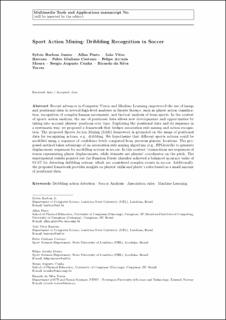| dc.description.abstract | Recent advances in Computer Vision and Machine Learning empowered the use of image and positional data in several high-level analyses in Sports Science, such as player action classifcation, recognition of complex human movements, and tactical analysis of team sports. In the context of sports action analysis, the use of positional data allows new developments and opportunities by taking into account players’ positions over time. Exploiting the positional data and its sequence in a systematic way, we proposed a framework that bridges association rule mining and action recognition. The proposed Sports Action Mining (SAM) framework is grounded on the usage of positional data for recognising actions, e.g., dribbling. We hypothesise that diferent sports actions could be modelled using a sequence of confdence levels computed from previous players’ locations. The proposed method takes advantage of an association rule mining algorithm (e.g., FPGrowth) to generate displacement sequences for modelling actions in soccer. In this context, transactions are sequences of traces representing player displacements, while itemsets are players’ coordinates on the pitch. The experimental results pointed out the Random Forest classifer achieved a balanced accuracy value of 93.3% for detecting dribbling actions, which are considered complex events in soccer. Additionally, the proposed framework provides insights on players’ skills and player’s roles based on a small amount of positional data. | en_US |
